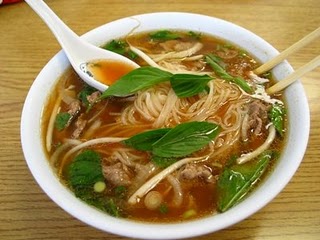Pho Sa Te: The Mystery Continues

Pho Sa Te is a spicy peanut noodle soup whose unclear origin only adds more to its fame and mystery.
Pho sa te is a chewy Chinese rice noodles soup with slices of cucumber, bits of ba tai or raw beef cooked in the broth, and perhaps what makes the meal deliciously mind-blowing, is a smooth, peppery peanut sauce which is all the rage in Vietnam.
According to some, pho sa te originated in China, in the eastern portion of modern day Guangdong Province Teochow. It used to be a simple street food sold in the sidewalks in a wooden noodle cart with only stools to serve as chairs, and with the police having to chase the vendors away from time to time. But back then, the dish was already known for its exceptional taste that it was feautured on VTV. Today though, the famous peanut noodle soup is sold in a spotless steel cart and has increased to VND70,000 obviously due to popular demand.
To others though, pho sa te is not a Chinese meal but Malay. According to a researcher at Australia National University Professor Tana Li, who was written extensively about Chinese trade and Vietnamese society, the dish was brought in between the 18th and 19th centuries by Straits Babas, offspring of Malay-Chinese marriages and rich and powerful in Malacca and Singapore.
Another professor, Erica Peters, believes pho sa te may have been brought to Saigon by Teochow settlers living in Cambodia, while Michael Arnold, a local Kiwi food writer who studied the dish discovered that “sa te” is a “mellowed variation” of an Indian curry introduced by Chinese traders.
Based on another legend, there was a girl named Phuong who, everyday at 4pm, rolled her grandfather's old wooden noodle cart outside their home and started selling hu tieu sa te. Her mother sits by her side while she sells the food, while her two uncles sell the same meal at the end of the street. Phuong was the designated protector and keeper of the recipe, but she believes it was her grandather who invented the dish about 60 years ago.
Phuong's version, original version as it may, of the legendary meal is a coarse mix of peanuts and chilies which gives the dish its rich and spicy kick. Tripe is infused to the concoction, as well as nicely-cut meat, rice vinegar, and chili paste. Today, she and her husband are still selling the mysterious broth in a neat dining place in Vietnam, but the couple is thinking about moving to Queens, New York where, aside from selling jewelry for the last few years, may open a pho sa te shop, confident it will gain the same notoriety as in their native hometown.
While pho sa te had a humble and even mysterious beginnings, today it can be found in many shops along the neighborhood with several variations to make the dish even more interesting. Some add deer meat to the peanut broth, while others add in offal and beef balls.
As rich as its peanut broth, so is Pho Sa Te's history. Its spicy yet delicious combination of flavors and textures are neither exclusively French, Chinese, Thai, Indian, or Malay, but a beautiful balance of them all. Though it doesn't have a clear beginning, it definitely has a promising future.









